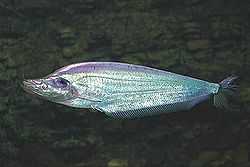Siluridae
| Siluridae Temporal range: 11.6–0Ma Upper Miocene - Recent | |
|---|---|
 | |
| Phalacronotus apogon | |
| Scientific classification | |
| Kingdom: | Animalia |
| Phylum: | Chordata |
| Class: | Actinopterygii |
| Order: | Siluriformes |
| Family: | Siluridae G. Cuvier, 1816 |
| Genera | |
| |
Siluridae is the nominate family of catfishes in the order Siluriformes. There are about 105 living species of silurids in 14 genera.[2]
Although silurids occur across much of Europe and Asia, they are most diverse in Southeast Asia, beyond which their diversity decreases in temperate East Asia, the Indian Subcontinent, Southwest Asia, and Europe. Silurids are apparently absent from much of central Asia.[2] The family can be divided into two groups, a temperate Eurasian clade and a more diverse subtropical/tropical south and southeast Asian clade.[2]
These catfish do not have spines before their dorsal fins or adipose fins, and their pelvic fins are either small or absent. The anal fin base is usually very long.[3] The largest species in this family is Silurus glanis, the Wels catfish.[3]
See also
- Glass Catfish
References
| Wikimedia Commons has media related to Siluridae. |
- ↑ Roberts, T.R. (2014): Wallago Bleeker, 1851 and Wallagonia Myers, 1938 (Ostariophysi, Siluridae), Distinct Genera of Tropical Asian Catfishes, with Description of †Wallago maemohensis from the Miocene of Thailand. Bulletin of the Peabody Museum of Natural History, 55 (1): 35-47.
- ↑ 2.0 2.1 2.2 Bornbusch, A.H. (1995). "Phylogenetic relationships within the Eurasian catfish family Siluridae (Pisces: Siluriformes), with comments on generic validities and biogeography". Zoological Journal of the Linnean Society, 115: 1–46.
- ↑ 3.0 3.1 Froese, Rainer, and Daniel Pauly, eds. (2015). "Siluridae" in FishBase. February 2015 version.
| Wikispecies has information related to: Siluridae |